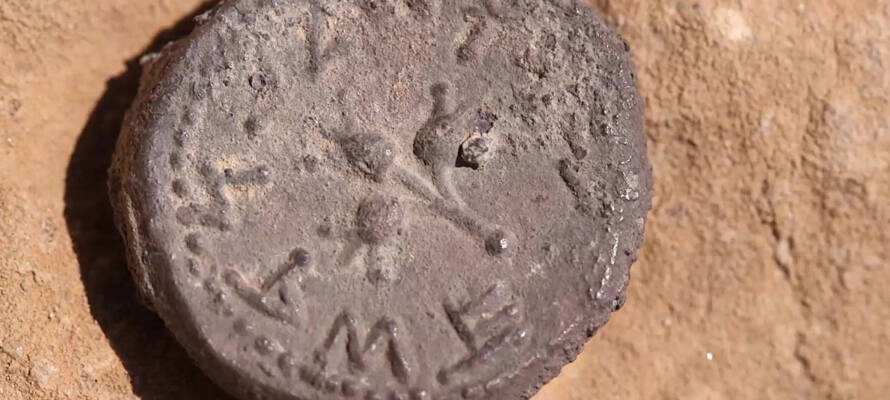The 2,000-year-old coin features the inscription “Holy Jerusalem” in ancient Hebrew script.
By Ben Rappaport, United with Israel
A rare 2,000-year-old half-shekel coin from the first year of the first Jewish revolt (Great Revolt) against the Romans has been discovered in the Judean Desert, Israel Antiquities Authority revealed Tuesday.
The coin is inscribed in ancient Hebrew script with the words “Holy Jerusalem.”
The coin, dated to 66/67 BCE, was discovered during a cave surveying operation in the Judean Desert aimed at discovering archeological treasures before thieves do.
IAA officials had reached a section of cliff at a stream in the Ein Gedi area when they suddenly noticed the silver coin sticking out of the ground at the entrance to one of the caves.
One hypothesis explaining how the coin might have gotten there from Jerusalem is that it had fallen from the pocket of a rebel who descended to the desert during the revolt, maybe en route to nearby Ein Gedi.
The IAA noted the coin also features three pomegranates, a symbol familiar from the the lira used in Israel until 1980. On its other side is a picture of a goblet, above which is the Hebrew letter Aleph, marking the first year of the outbreak of the rebellion, as well as the words “Hatzi Shekel” [half shekel] indicating the value of the coin.
The authority also pointed out that, in accordance with the biblical commandment against making graven images, the Jews would inscribe symbols from the plant world and themes from religious worship and holiness for their coins, in contrast to the pagan world, which would take themes from daily life, such as the faces of animals and emperors, for its coins.
According to the IAA the Jewish rebels minting their own coins with Jewish symbols and motifs was also an act of defiance that worked toward the creation of an independent “rebellion economy.” Therefore, it is unsurprising that the rebels chose to use ancient Hebrew script, which was common hundreds of years earlier, for the coins, as opposed to the Greek script common during the Second Temple period.
It is estimated that such coins were minted in Jerusalem, maybe even in the Temple complex itself.
IAA researcher Yaniv David Levy said that “During the time of the Second Temple, pilgrims used to raise a tax of half a shekel to the Temple. The accepted currency for paying this tax for almost 2,000 years was the Tyrian shekel. When the revolt broke out, the rebels issued, as mentioned, these replacement coins which bore the inscriptions ‘Israel shekel,’ ‘half shekel,’ and a quarter shekel. It seems that the worship of the Temple continued even during the rebellion, and these coins were also used by the rebels for this purpose.”
“Finding a silver half-shekel coin from the first year in an organized archaeological project is a rare event in Israel, in general, and in the Judean Desert, in particular,” said Amir Ganor, director of the Theft Prevention Unit at the IAA, according to Israel Hayom.
“The current discovery shows how important it is to survey the entire area of the Judean Desert systematically and professionally. Every successful item discovered in the survey adds more information about the history of our nation and country.”
“If the survey had not been carried out, the coin might have fallen into the hands of antiquities thieves and sold in the antiquities market to the highest bidder. During the six years of this operation, we have documented over 800 caves and discovered thousands of valuable and important finds,” Ganor noted.
